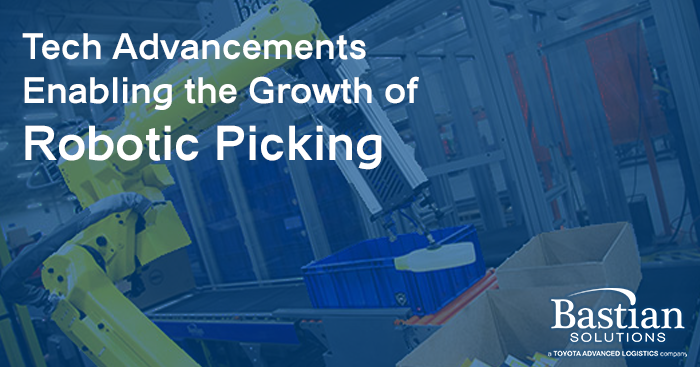
Technological Advancements Enabling the Growth of Robotic Picking
Jason Tenorio | 04 April 2019
Advances in machine vision, artificial intelligence, end-effector/gripper design, and mobile robotics have enabled a growing trend of robotic picking applications for distribution and manufacturing clients alike. In the very near future, robotic picking will become mainstream, allowing a further reduction of labor requirements while facilitating a 24/7 picking and order fulfillment environment.
Tech Improvements Enabling Robotic Picking
Machine vision has dramatically improved; it is simply much faster and more effective than prior implementations.
Artificial intelligence improvements, neural networks, and unsupervised training environments have allowed for a much-improved training environment to deal with the uncertainty associated with mixed SKU bin picking. This has allowed many more permutations in training exercises and better coverage in pick scenario planning.
End-effector (or end of arm tool) design has improved to naturally mimic natural grasping. These improvements have enabled a more capable gripping mechanism while improving the ability to maintain grasp of an object while moving to pick locations.
Mobile robots have improved in their safety, speed, and capacity thus allowing for applications in real-world application areas like pick modules and kitting cells.
Robotic Picking Capabilities
Robotic each picking, along with full case picking, will now be able to dramatically increase in their implementation scope. Pairing robotic picking with goods-to-person technologies will usher in a new wave of goods-to-robot implementations. Integrating robots with mobile bases will allow autonomous, robotic picking (similar to traditional pick modules) but with minimal labor and/or ergonomic stresses.
Backend systems need to be comprehended with a continuous order cycle in mind and designed to accumulate WIP allowing for the full benefit of these 24/7 pick systems. Clients who receive orders over a 24/7 window will now have the availability to reduce machine rate requirements by allowing a three-shift operation vs. two shifts, reducing the system sizing rates and overall capital spend while allowing for a quicker ROI.
As these robotic pick technologies continue to improve, and clients adopt them, forward-thinking customers will be able to receive a multitude of benefits from using them.
Jason Tenorio is the Sr. Director of Consulting at Bastian Solutions. In this role, Jason leads client consulting engagements and develops new opportunities for consulting work with external customers. He has a Bachelor of Science in Mechanical Engineering as well as a Master of Science in Industrial Engineering and has nearly 30 years of design, simulation, consulting, and technical sales experience.
Comments
No comments have been posted to this Blog Post
Leave a Reply
Your email address will not be published.
Comment
Thank you for your comment.